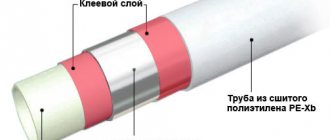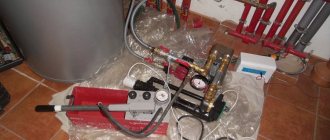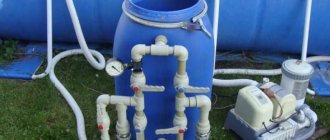Published: 03/09/2013 Category: Materials and technologies, Plumbing work Views: 12968
Protection of water pipes from freezing
Freezing of water supply system pipes is a very pressing problem today, which is caused by low temperatures in the winter season. Low temperatures lead to freezing of water inside the pipes. This is fraught with a violation of the integrity of individual elements of the water supply system and their destruction, which ultimately leads to the failure of the entire water supply system. There is a need to take countermeasures to eliminate the problem - freezing of water pipes and freezing of water in the elements of the water supply system. Restoring the functioning of the water supply system can take a very long time, which in turn will inevitably require significant funding. It is much more advisable to prevent a problem than to eliminate its consequences in the future.
There are several ways to prevent freezing of pipes and elements of the water supply system:
- install a heating cable for water pipes;
- remove all water from the water supply system;
- ensure constant water pressure in the water supply;
- carry out additional insulation of pipes;
- carry out additional insulation of the basement and basement of the house, install a heater;
- ensure constant circulation of water in the system;
- ensure constant maintenance of a positive temperature in the house in winter;
These methods can be used in combination or independently, depending on operating conditions. If implemented correctly, the final result will be positive.
How to heat water in a pipe underground
The best solution to the problem of frozen pipes is the correct installation and use of insulating materials. As they say, it is easier to prevent problems than to desperately solve them later. Therefore, dig trenches at a level that will not freeze even in the harshest winter. But if you do not have this opportunity due to climate or soil conditions, then be sure to use materials for thermal insulation and protection from moisture. Moreover, this is true for both metal and plastic.
The photo shows frozen water in a plastic pipe
And yet, what to do if the water in the pipe has already frozen? There can be two options for water pipe icing: inside the house (indoors) or outside (outdoors). The first is less common, but it is also easier to fix the problem. The second case is more complicated, although fortunately it is also not hopeless.
In any case, there are some universal tips:
- During defrosting, water taps must be open to allow melt water to drain from the pipes. Its temperature is lower than usual, and this greatly increases the risk of re-freezing;
- The easiest way to identify an ice plug is by touch: the frozen section is much colder than the rest of the pipe;
- Once the problem is fixed, it must be prevented from happening again. To do this, open sections of the water pipe must be reliably insulated using special thermal insulation materials.
Nowadays, metal-plastic pipes are used almost everywhere, so below are methods that are primarily suitable for them.
What temperatures can metal-plastic pipes withstand?
As an option, I considered metal-plastic polyethylene pipes as an improvised water supply for the dacha. The main difference is the aluminum layer under the polymer coating.
This gives an increase in strength, increases the operating temperature thresholds to +950 C, but there is a big “BUT” - the temperature of the liquid inside should not drop to 00.
Unlike HDPE pipes, these burst without ceremony.
I would not lay metal-plastic pipes without insulation (especially on the ground), because they will tear one hundred percent.
After the first freezing cycle, the fittings and seals will depressurize, and the metallized layer will swell into a hernia. If you set out to make a winter water supply out of them, then only underground, with a slope and a heating cable along the entire system.
But as a summer option, metal-plastic will do just fine - pipes made from it are stronger and can withstand pressure up to 2.5 MPa. It’s not scary to run over them with a car; any pressure can be applied.
Effective ways to heat the mains from the outside
To start working with your own hands, you need to unscrew the water supply taps or the outlet valve. The effectiveness of the technique will be determined by the degree of liquid leakage.
Hot water
If you do not know how to thaw a frozen water pipe connected to a building or located in an unheated basement, use boiling water treatment:
- Wrap the outer section of the line in several layers with rags or old things that absorb liquid well. This will prolong the contact of water and the walls of the product.
- Heat the water to boiling water.
- Cover areas that do not require heating with insulating fabric to prevent movement of the plug.
- Water the wrapped area until the fabric is wet until the ice melts.
- The system warm-up period is up to 12 hours.
Using a hair dryer
A powerful jet of hot air warms up a separate area when the communications are inside the building. The work is performed according to the following algorithm:
- A special casing of film or metal is made around the structure, which eliminates heat loss.
- Open water supply taps and valves.
- Blow the communications evenly from all sides with a construction hairdryer.
- They carefully work out the entrances to the fittings, narrowings and turns to melt the ice.
Using electric current
A welding machine will help melt an ice plug or remove deposits in a pipe underground in a residential building. The device is only suitable for metal structures, since they will be conductors.
Principle of operation
When the device is turned on, an electric field is created, activating the electrons and giving them direction. When the elements collide with ions, they produce thermal energy. Metal products are also heated by the current, and the generated heat is transferred to the ice, so the plug is gradually pushed inside the water pipe.
How to use?
If you do not know how to efficiently heat frozen water in a metal pipe located underground or above the ground in a private house, follow the following procedure:
- Wear thick rubber gloves.
- Open valves and taps.
- Dig or open the desired area.
- Touch the pipe with the electrodes.
- After melting, the water will begin to flow in a thin stream.
"Soldier's boiler" technology
Plastic water supply heats up well if you use a two-core copper wire with a cross-section of 2.5 mm. A homemade tool immersed inside the pipe will gradually boil the liquid and direct it to the drain system. The process is carried out in stages:
- The top insulating layer is removed from the wire.
- A plug for the socket is screwed onto one end of the wire.
- The second core is exposed and wrapped around the pipe for 3-4 turns.
- The excess is cut off with pliers.
- The second core is twisted at a distance of 1-2 mm from the final turn.
- Connect the plug to the electrical outlet.
Heating cable for water pipes
This method of protecting pipes from freezing has been used relatively recently. Here the main element is the heating cable. In this case, it can be located either on the outside of the pipe, enveloping it, or inside the water supply. In both cases, the part of the water supply system element that needs additional thermal insulation is pre-wrapped with a layer of foil. This will minimize possible heat loss.
Cable heating systems
- these are ready-made kits consisting of wires of different lengths, with a certain power, a plug at one end and a thermostat at the other end of the cable. The thermostat ensures that the pipe is heated at a given temperature and can independently turn on or off the heating system within a given temperature range. Many kits also include a thermostat that allows you to control temperature and energy consumption.
The main advantages are the possibility of installing it both on pipes running underground and on the surface, while on average the energy consumption of the heating system is small - about 15 W/m, and, above all, depends on the expected minimum air temperature and the thermal insulation of the pipe.
However, it is important to remember that if the power supply is cut off, the heating system also stops functioning. The occurrence of such a situation must be foreseen in advance
To ensure uninterrupted power supply, it is worth purchasing and installing an additional autonomous power generator.
The most famous and popular manufacturers of cable heating systems are companies such as Ebeco, Tyco Thermal Controls, Ensto, Nelson EasyHeat, Raychem, Nexans, Special Systems and Technologies, etc.
External location of the heating cable
The heating cable can be located along the pipe in one or more lines
.
Another option for placing the heating element is in a spiral along the pipe
. When installing the heating cable, it is necessary to ensure that the cable pitch is uniform.
A wavy line along the pipe
the heating cable is placed if the length of the cable is too long for the linear method of placement, and insufficient for the spiral method.
1. Temperature sensor 2. Heating cable 3. Water pipe 4. Adhesive tape 5. Thermal insulation
Internal arrangement of heating cable
When placing the heating element internally, a cable with a special coating is used. The top layer of the cable allows this method of pipe insulation to be used in drinking water pipelines. It should be noted that when using a heating cable there is no need to place the water supply system at great depths.
As a rule, the heating cable is installed inside the pipes if it is not possible to lay it outside. For internal installation, cables use special kits designed for installation in water pipes with a diameter of 1/2″ to 1″.
Anti-freeze taps
A common reason for the lack of water in the pipeline is a frozen tap. This is especially true if water for domestic needs in winter must be collected from the yard or used for irrigation during periodic frosts. A tap that is installed in the ground is called a hydrant. It is a piece of pipe up to 1.2 m long with a lever at the top and a valve at the bottom. There is another pipe of smaller diameter inside.
One end of the hydrant is connected to the water main, the other is above the ground and serves to supply water. When the handle is lifted, the valve of the inner tube, connected to the lever via a rod, is activated. After lowering the handle, the valve shuts off the access of water, and the remaining water flows through the external pipe back into the water supply. This way, no liquid remains in the hydrant, which means there is no risk of it freezing.
The design and principle of operation of a tap connected to a home network are similar to an underground hydrant, but with some differences. The structure is laid in the wall. At the outer end there is a valve and spout, at the other end there is a check valve with a stem. Product length from 15 to 60 cm for walls of various thicknesses. Since the shut-off valve is located in the positive temperature range, the faucet does not freeze even in severe frost.
By turning the valve, the valve opens and water flows into the spout. When the handle is rotated back, the pipe lumen closes. The remaining liquid is spontaneously removed and the pipe remains empty.
Ways to prevent freezing
The most effective methods for preventing the formation of ice jams include:
- Correct installation of the pipeline to a sufficient depth.
- Arrangement of sand and gravel cushion.
- Thermal insulation of the system.
- Supply of the pipeline with heating cables with temperature sensors.
Do not overuse heating using a heating cable.
In addition to the fact that this is a significant waste of electricity, continuous operation will shorten its service life several times. Be sure to remember that high-quality protection of pipes at the stage of their installation will greatly facilitate their operation in the future. No matter how carefully the work to warm them is carried out, there is a very high risk of damage from the direct expansion of the ice inside. There is a high probability that with the onset of heat it will be necessary to carry out repair work and replace damaged sections of the system.
Add a comment
Constantly circulating water
When it is not possible to resort to technical sophistications, it is enough to simply leave a tap open so that the water constantly flows in a thin stream. The method is simple. Yes, it is not always justified because if water flows into the septic tank, it overflows, because... even the thinnest stream can turn into hundreds of liters per day. In this case, already purified drinking water is poured out. In addition, electricity is senselessly wasted on its supply. Another disadvantage of this method is that summer residents often simply forget to open the treasured tap. After all, the habit of keeping the water well closed makes itself felt. And this, as you might guess, leads to freezing of the water supply.
Is it possible to properly circulate water? Can. To do this, you need to duplicate the water pipe. The second one will be used as a return line. During operation, the pump pumps water out of the existing well, drives it through these two pipes and returns it back to the well.
To reduce the load on the pump, you can set a timer. With its help you can set the frequency of operation of the unit. For example, 1-2 minutes of work after 30 minutes of rest. At the same time, the water will not have time to freeze, and electricity will be saved.
When a liter of water freezes, 330 kJ of thermal energy is released. In terms of cotton wool, this amounts to 90 W*hours. Heat loss per linear meter of pipe is approximately 10-15 W.
When we know the diameter of a given pipe and the volume of water that is in it, we can calculate the frequency of pump operation with which it is necessary to replace cooled water with warmer water from the well.
Temperature depending on the indicator
To clearly determine the freezing point, you must first understand how these 2 parameters are related.
How are they interconnected?
As the pressure increases, the freezing temperature decreases, and as the pressure decreases, the temperature increases. There are special formulas that help calculate a specific value .
The table of such ratios looks like this:
| Temperature, °C | Pressure, mPa |
| 0 | 0,1 |
| -1 | 1 |
| -2 | 30 |
| -3 | 40 |
| -4 | 50 |
| -5 | 60 |
| -10 | 110 |
| -22 | 210 |
Defrosting sewer pipes
In the event that a sewer pipe within a building is frozen, the heating methods described in the previous section will help us. But what to do if a pipe underground on the street freezes? It is pointless to water the soil above it with hot water, and waiting for the onset of heat is too long. There are several ways to correct the situation.
If a metal sewer pipe is frozen, you can use the already mentioned method of heating by applying current. But the difficulty is that you will have to violate the integrity of the soil above the pipe, which is very problematic, since it is frozen. If this frightens you less than the lack of the benefits of civilization over the next three months, then you will need to dig two wells along the edges of the icy area. You can also spend money on purchasing special equipment if this problem is systematic. The actions are almost the same as those already written. The only difference is that there is no need to turn the device on and off (when purchasing a special heating device).
It is impossible to carry out heating using high temperatures immediately in the middle of a frozen area. The melted liquid will have nowhere to go. Always defrost ice from the edges of the mash.
You can act differently. We will need to independently build a simple device from a long piece of two-core cable, a water heating element (TEN), a small board and a fork. We connect a plug to one end of the cable, and a heating element to the other. We make sure that the edge of the base of the heating element rests against the edge of the board, and its spirals do not touch it. The device must be moved using a rigid cable. We insert it inside the pipe from the side that leads to the drain (septic tank). It is impossible to approach the ice jam from the wastewater inlet, since the thawed liquid will have nowhere to leave the system due to its angle of inclination. When the element rests on the ice, we turn it on, when we move it forward a little, we turn it off.
Laying and installation of HDPE pipes in winter
Since polyethylene becomes stiffer at subzero temperatures, installing a water supply is more difficult. It is sometimes impossible to roll out a coil, and it is better to use pipes in sections.
The bay can be used if you pre-warm it in a warm room. If the work goes on all day, the procedure should be repeated periodically.
A mandatory tool for winter installation of HDPE pipes is a gas burner. You will use it to soften the ends of the pipes, which will return them to their round shape (under external load they become slightly deformed and, once frozen, no longer fit the fittings). With a burner you will heat up and restore flexibility to the pipe section if it needs to be straightened, or vice versa, bent.
When welding long routes of HDPE pipes, it is worth using a special welding tent. The temperature in it is positive, but not necessarily high - + 5° C is enough. Up to - 10° C, welding can be done without a tent, but keep in mind that the warm-up time will be longer. The ends of the pipes should be plugged so that cold air does not interfere with the heating of the joint.
Also make sure that there is no snow inside the pipe (it often gets into the pipes during unloading). Melted water can ruin joints, and even the welding machine.
The labor intensity of installing polyethylene pipes in winter is twice as high as in summer.
Activities when water pipe frost protection works
To prevent this, it is necessary to protect the water supply from freezing by insulating the water supply inlet. Thermal insulation made from various materials is used for these purposes: mineral wool, foamed polyethylene, extruded polystyrene and others.
You should also separate the pipe body from contact with the wall of the building. This reduces the likelihood of water freezing in the pipe and acts as additional protection for the water supply from freezing.
This entire pipe, from ground level to entry into the house, along with thermal insulation, should be enclosed in a tray or “bedside table” made of brick or other available means and covered with roofing material.
Thus, the covered tray prevents the destruction of thermal insulation from atmospheric influences: precipitation, wind and sun.
But, sometimes, all this work is not enough to completely protect against freezing of water in the pipe, therefore, in addition to thermal insulation, you should use a heating tape or, as they say in everyday life: a heating cable. There are two types of heating cables - resistive and self-regulating.
To put it simply, a resistive cable is a heating element made in the form of a cable. To control it, you need a thermostat that supplies a certain voltage, depending on the length of the cable.
Self-regulating cables are free from this drawback, since they use a polymer matrix as a heating element, along the edges of which conductors pass. Therefore, this cable can be cut into arbitrary pieces of the required length, which will perform its function and the heating temperature of the tape will depend on the air temperature.
This allows you to prevent the pipes from “defrosting” and even warm up the frozen water in the pipes, restoring the lost water supply. The cable is attached to the pipe in the problem area, that is, from the inner wall of the building (entry point) and to the lowest freezing point of the soil (if the water supply goes into the ground).
The electrical connection of a self-regulating cable does not cause any special problems and this work can be performed by any developer who knows how to hold a screwdriver in his hands.
You can power the cable only when necessary, in severe frosts, thereby reducing electricity consumption. Having applied the entire list of works, you can be sure that the protection of the water supply system from freezing will work reliably in winter.
Main problem areas of water supply
The area where the water pipe exits from the well or well - the water intake points, the area where the pipe enters the house - these are the main problem areas that need to be paid special attention to first. When planning the organization of water supply at home, it is necessary to take into account the possibility of freezing of pipes and lay them at a depth greater than the level of soil freezing in the region. A general recommendation would be to lay water pipes at a depth of 1.5-1.7 m. In this case, the pipe should be insulated.
A more difficult task is the insulation and alteration of already laid pipes, especially when it is not possible or difficult to lower them to a sufficient depth. In this case, all that remains is to additionally insulate the pipes and use heating cables to prevent water from freezing. One of the “folk” methods of insulation is the use of a sewer pipe, which is placed over a water pipe, and the voids between them are filled with foam. This method, of course, does not guarantee that the pipe will not freeze in difficult areas - at joints and branches of the pipe. In such places it is better to use a heating cable.
Pipe heating with cable
Currently, this method is most widespread. The idea is simple. After all, winter, even the harshest, lasts only a few months. Therefore, the pipeline can freeze only during this cold period.
If instead of 2 meters you bury a pipe 50 cm deep, wind a heating cable around it and insulate it, then the water will not freeze.
If you take a branded cable, then its cost can range from 400 to 500 rubles. per linear meter. The distribution power is 10-20 W per linear meter. If you want something cheaper, you can use regular wire. A heating cable made at home is usually low voltage. In theory, it can be used both outside the pipe and inside. However, it is worth remembering that even at low voltage, the current can affect pets.
Typically, the water supply freezes where the pipe enters the house. If you wrap it with a few meters of cable, the problem can be eliminated.
Work with heating pipes
Some believe that this problem cannot affect them, because they live in regions where severe winters are not observed. But this is a deep misconception. At what temperature do you think heating pipes freeze? Only at −30°C? No, for water to freeze in those parts of the system that are laid under the house (and very close to the external walls) -7°C is enough. And if heating is not used in winter (for example, you left home for a while), then −8-10 ° C is enough for the pipes to freeze inside the building itself.
If you want to protect yourself from burst pipes due to freezing, then when purchasing materials for your heating system, choose plastic rather than metal pipes.
Let's look at several options for how to warm up a frozen heating pipe in a house.
Hot water
The most primitive method of dealing with ice jams. Its effectiveness is extremely low, time and labor costs are very high. The action plan is as follows: wrap the problem area with thick cloth, place a large container underneath and begin pouring hot water over the cloth. This manipulation is repeated every 10-15 minutes. The temperature should be about 80°C, no more. Depending on the size of the problem area, it may take from 2 to 10 hours to warm it up.
Hot air
The easiest and least burdensome way to destroy an ice jam. Its effectiveness, like that of the previous option, is low, but it will not require any excessive effort from you. Using a hair dryer (use time - 2 minutes, rest time - 5-7 minutes), or an ordinary household or standard fan heater, we heat the surface of the pipe with a stream of hot air.
Thermal conductivity
This method is the most expensive if there are no wires from the heated floor system. It is unlikely that you will be able to buy them separately; you will have to purchase the entire system, even if it is of the smallest size. These heating elements are wrapped around the frozen area and connected to the network. The time spent heating the element is approximately halved compared to previous options.
Electrical conductivity
The most effective option for heating frozen liquid in the elements, but not suitable for every system. If the pipes are not made of metal, you will have to choose something else. To defrost, you will need any electrical transformer with additional resistance (for example, a welding machine). We connect the terminals from the cables at the edges of the frozen area and turn on the current supply. A prerequisite is to alternate turning the device on and off. Constant work can damage it. Warming up time takes no more than two hours.
Some craftsmen recommend heating the elements using a propane torch. This is incorrect, since the use of such a technique is strictly prohibited. Because of it, the integrity of the pipe body can be damaged, which will lead to a leak.
Tip #1: Keep the heating on
If you or your tenants are going away for an extended period of time, make sure the heat is maintained in your apartment or home. It can be difficult to convince your tenants to leave them on when they are away, especially if they are responsible for paying their own utility bills. You should let them know that heat can help prevent pipes from freezing, and if pipes freeze and burst, it can cause significant water damage to the property.
It is not necessary to maintain the temperature as you are used to during your permanent stay, but it is advisable that it does not fall below +10°C. This should provide enough heat to keep the pipes warm and prevent the water inside from freezing.
Additional thermal insulation and insulation of water pipes
The most popular protection against freezing of pipes is the preliminary adoption of measures for additional thermal insulation of the water supply system and water pipes. The materials used can be very different.
Mineral wool.
This type of insulation is used quite often. It is in great demand in construction. Its advantages include resistance to temperature changes, ease of installation work, and the ability to perform its immediate functions for a very long time.
Foamed polyethylene.
It is distinguished by its availability and high thermal insulation properties. The top layer of insulation based on foamed polyethylene is made of foil, which allows heat to be reflected inward, which further reduces heat loss.
Polystyrene foam (expanded polystyrene).
Foam insulation for pipes is presented in the form of a kind of cover (box), consisting of two halves in a longitudinal section. To insulate the connecting nodes, a special foam shell of various shapes is used. The individual elements are fastened manually.
Most summer residents do not leave their plots for a long time even in winter: they come on weekends and holidays. Nowadays, people are so accustomed to comfortable conditions that they do not agree to draw water from a well with a bucket, wash dishes in a basin, or bathe in a trough. We need such a benefit of civilization as cold and hot water from the tap at any time of the year. But frosts test the strength not only of our health, but also of the creations of human hands.
Perhaps you, too, have encountered problems with winter dacha water supply. We’ll talk about them, or rather about how to avoid them.
Of course, if you personally designed and built your dacha, then you took care in advance of the safety of the equipment and the uninterrupted operation of all systems at any time of the year. Fortunately, there are now many ways to protect water pipes from freezing: the latest thermal insulation materials or cable heating of pipes.
What should those who bought a dacha building and are forced to use what they have do? How can you inexpensively and reliably protect ordinary utility lines in winter so that they do not freeze and fail?
There is an opinion that pipes laid below the soil freezing level are safe in winter. This is not entirely true. The degree of soil freezing is influenced by several factors: its density and humidity, duration and severity of frost. For example, for Central Russia, the recommended pipeline laying depth is 1.5 m. But, as practice in recent years shows, the freezing depth in February-March reaches 1.8 m.
If you are sure that your water supply is hidden at a safe depth, just drain the water from the heating system and you can safely leave for the city. The only advice in this case: leave the water flowing from the taps in a thin stream. As long as there is water movement through the pipes, the risk of them freezing is reduced significantly.
Special materials for thermal insulation
It is not necessary to use a cable to protect pipes from freezing. Special thermal insulation materials can cope with this task. There are many varieties of them on sale.
The most popular materials used for thermal insulation of pipeline systems:
- Fiberglass thermal insulation (also called glass wool). This material is most often used for insulating metal-plastic pipes. Glass wool requires good insulation as it crumbles due to its low density. Roofing felt and fiberglass are best suited for this.
- Basalt insulation is sold in the form of cylinders. No special trays are needed for its installation, and the material itself consists of basalt fiber. For a protective layer, parchment, foil and roofing felt are excellent for this insulation.
- Foamed synthetic rubber is distinguished by the fact that this material for thermal insulation of pipes is very elastic and flexible. This insulation is sold in tubes of various diameters and in sheets. Foamed synthetic rubber is used mainly to protect water pipes from freezing, as well as heating and sewer systems (pro
Removing water from the water supply
As you know, what does not exist cannot deteriorate. As well as freezing too. For this reason, during a long absence, wise people simply drain the water from the system in the fall.
For those who have a submersible pump in the well, it is enough to make a small hole with a diameter of 2-3 mm in the hose next to the pump. In this case, immediately after turning it off, all the water from the system will drain back, i.e. into the well. A check valve is installed at the opposite end of the pipe, allowing air to fill the pipe as the water drains. When the pump is turned on again, this valve closes and water flows freely into the water supply.
Those summer residents who have suction pumps located in the basement or directly in the house may encounter some difficulties.
The fact is that there is a check valve at the inlet end of the supply pipe. It prevents water from returning to the well. Therefore, in this case, the system will have to be supported by water supplied from some container. Organizing this is not difficult. Bringing the system into working condition will take a few minutes. However, when leaving, you will need to remember to drain the water from the system.
What are the dangers of freezing pipes?
As you know, when water freezes it expands. If you pour water into a glass jar and put it in the freezer, after a few hours you will find that ice has formed inside and the jar is cracked. The same thing happens with water pipes - cracks and breaks appear in their walls. After the system defrosts, leaks form in places of damage: water flows out of the formed holes and is absorbed into the ground, gradually forming a flooding zone. At the same time, soil particles enter the water supply system, contaminating the water, which can easily result in an infectious disease or parasitic infestation.
To correct the damage, you have to dig a water supply trench and inspect the entire system. As a rule, in this case, experts advise completely replacing frozen pipes: even if some section of the water supply system looks intact, the resulting microcracks can render it unusable within a couple of years. Therefore, insulating pipes, no matter how expensive it may be, still ends up being a more profitable and reasonable step than repairs that are inevitable after freezing.
Reasons for defrosting heaters
The main reasons for freezing of air heaters are:
- Winter period: outside temperature drops below -10 degrees.
- The coolant temperature in the supply pipeline is below +45 degrees.
- The amount of impurities contained in the pipeline system operating for the ventilation system exceeds permissible standards, which leads to clogging of individual heat exchanger coils and, as a result, freezing of water in these areas.
- The power supply to ventilation systems is intermittent and the circulation pump is turned off.
- Features of the design of heat exchangers (water heaters). Most European manufacturers make heat exchanger tubes with a smaller diameter than required for operation in Russian conditions.
- Incorrect choice of control unit circuit.
- Control valves are selected with high Kv, and drives with low speed.
- Lack of return coolant sensor and capillary anti-freeze thermostat.
- Faulty automatic systems, lack of frost protection.
- Uncoordinated operation of exhaust systems when the supply systems are turned off (air leaks through closed blinds), etc.











